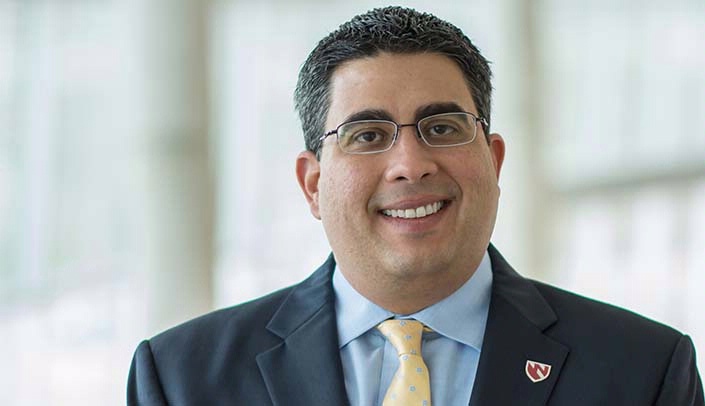It’s a debilitating disorder that causes people to feel like they are going to fall down when they are standing.
Complex protocol
Patients underwent a complex protocol of 12 different procedures in clinic. These included:
- a functional magnetic resonance imaging (MRI) exam;
- an electromyogram (EMG), a test used to record the electrical activity of muscles;
- a virtual reality exam;
- a biomechanical exam; and
- several tests that record brain and eye activity.
It’s called primary orthostatic tremor (OT), and this week UNMC conducted the largest international study on the rare movement disorder, with nearly 90 OT patients coming to Omaha from around the world.
“It’s a very rare condition, so it’s quite an achievement to get so many patients to congregate in Omaha,” said Diego Torres-Russotto, M.D., a movement disorders specialist at UNMC. “OT is a miserable disease.”
Dr. Torres-Russotto, who is an associate professor in neurological sciences, said patients came from Europe, Canada, Australia and from throughout the United States.
Facts about OT
Some other facts about OT include:
- It is more common in females.
- There’s usually a 10-15 year lag between onset of symptoms and diagnosis.
- Onset typically occurs around age 40.
- It won’t kill you, but it typically gets worse over time.
- Diagnosis is confirmed through the EMG test.
- By touching something, the feeling of falling improves.
For more information on OT, click here.
Patients are in Omaha all week, with clinic time each day to allow patients to be analyzed by a team of health experts. On Wednesday, the Orthostatic Tremor Research Symposium was held in the Fred & Pamela Buffett Cancer Center.
This marks the third time Omaha has hosted the event, with the previous Omaha meetings held in 2012 and 2014.
Dr. Torres-Russotto said the OT patients will be able to interact with health professionals from three UNMC colleges — medicine, public health, and allied health professions — as well as from the Biomechanics Lab at the University of Nebraska at Omaha.
Dr. Torres-Russotto said OT is greatly underdiagnosed and often misdiagnosed as other neurological problems such as Parkinson’s, essential tremor or psychogenic problems.
OT is characterized by high frequency tremors of the legs when in a standing position and an immediate sense of instability. Because of the speed of the contractions, OT is often not recognized as a tremor when compared to essential tremor or Parkinson’s disease.
“People with OT do not typically complain of tremors,” he said. “Their biggest problem is the sudden disabling event that occurs when they stand. They feel unsteadiness and imbalance while standing. They can only stand for a short period of time, in some cases only seconds.
“There might be a feeling of panic. They need to sit down or start walking to relieve their symptoms.”
OT is a repeating cycle that happens all through the day, he said. It is life-changing and unrelenting.
“It is an incapacitating disorder,” Dr. Torres-Russotto said. “It impacts your life in just about every way imaginable and makes routine tasks such as going to church, standing in line at the grocery checkout, even going to the bathroom a major challenge.”

My mother is a patient right now from a fall that caused her a fractured hip, any way as I read this article I had pictured my mom's moments of falling since she was 40 she is now 65 and I am going to be honest with you, I am wondering if this is a underlying cause of her falls through the years which caused her to have knee surgery done in the past and problems range from back injury to being anxious when she would go shopping, she would always tell one of girls"go get a wheelchair!" And would seem just irritated during the times we had went out and about. She never said anything about any odd sensation but she would mention at random times when she was home in her chair how she felt funny few days before while walking in the house but it never made sense to me because she wouldn't say during the falls how she felt she is always had a reason to what caused her to fall and she falls pretty much when nobody is around so I have always taken her word for it but this article has me really worried about my mom and the fact that maybe it's something that has gone undetected for years and years. How can I help my mom and her doctors to take this into consideration now that she is one of the worst position she could be in at her age.?
I've had OS for about 15 years now. Gabapentin helps but is needed more often…now on something else to help but it makes me tired and goofy. Can you help me? Thank you, Sheri Park at oogabooga2@aol.com. It is soooo debilitating and frustrating.
I am in Bosnia and Herzegovina(former Yugoslavia)and I am suffering from OT almoust 25 years without any therapy.If anybody can help me please contakt me,thank you